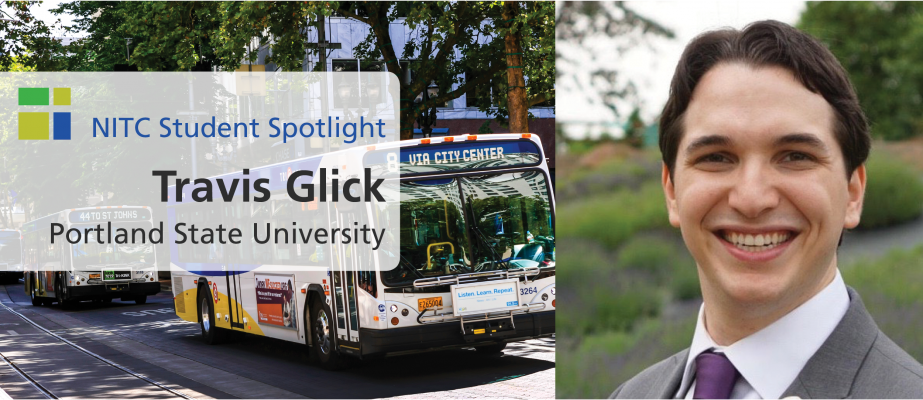Student Spotlight: 2018 NITC "Student of the Year" - Travis Glick, Portland State University

Travis Glick, Portland State University
Travis Glick is a PhD student, graduate teaching and research assistant in civil & environmental engineering at Portland State University. He served for two years as president of Students in Transportation Engineering and Planning (STEP), Portland State University's transportation student group. Travis is a 2018 NITC student scholar and two-time Eisenhower fellow, and will be presenting research on bus dwell times, bus-bike conflicts and transit modeling at the 2019 annual meeting of the Transportation Research Board (TRB).
Tell us about yourself?
I was born and raised in Chico, California and moved to Portland, Oregon in 2010 to attend the Portland State University Honors College. I was drawn to the puzzle of system-level problem solving and received a BS in Civil Engineering with honors in 2015 and a MS in Civil Engineering in 2017. I am now pursuing a PhD focused on transit network models. Outside of school, I enjoy piano, cooking, and reading science- fiction. Most of all, I enjoy spending time with my wife (a nurse-midwife) and our twin cats, Castor and Pollux.
What has influenced your path in transportation towards public transportation?
When I began working at PSU in 2014, I was not assigned a specific project; rather, I was given access to new high-resolution bus transit data and told to "be creative." I used the opportunity to develop new methodologies for examining short transit segments. This research was published and presented at the Transportation Research Board (TRB) 94th annual meeting and served as the basis for my undergraduate thesis comparing the effectiveness of four types of traffic intersections. I greatly enjoyed the research into public transportation and accepted an offer to continue as a research assistant at the graduate level. Few U.S. cities have implemented high-resolution archived data systems. TriMet has been a leader in its data collection tools for years. As such, Portland is one of the few cities where this type of analysis can be done. Combined with PSU's close working relationship with TriMet and Portland's Bureau of Transportation, working in Portland provides a unique opportunity to contribute projects that can be presented to and critiqued by the agencies that most directly benefit from the research. I enjoy this discourse, working on the challenges presented by network modeling, and developing new methodologies to improve public transportation.
Tell us about the research you’re currently working on and what you will be presenting at TRB?
My doctoral work tackles a new class of problem that accounts for multiple routes and multiple service connections. It combines stochastic modeling techniques with new, high-resolution data sources and route-level methodologies to model and analyze performance measures for an entire transit network. Previous network-level analyses rely heavily on deterministic network models that assume linearly dependent costs and travel times; however, there is significant non-linearity in how travel-times and transit costs are valued by users and agencies in real networks.
At TRB this year, I will be presenting research from three papers submitted for publication during my first year as a doctoral student. The first presentation examines the benefits of non-linear regression models to predict bus dwell at bus stops. These models improve the robustness of predictions against outliers and produce better estimations given inconsistent data. The second presentation examines the interaction effects of buses using the same stop even when those buses are from different routes. The proposed models account for both common and uncommon interactions and improve predictions for how long buses dwell at bus stops. These models can be applied within transit agency to improve prediction methods. The third presentation shows research using video and radar data that examines the interaction effects of passenger vehicles, buses, and bicycles at a heavily used multi-modal intersection in Portland. Results indicate significant delays are caused by bicycle and right-turning traffic and identify potentially dangerous interactions between cyclists and buses.
Individually, the above research efforts provide practice-ready solutions that may be applied by transportation and research agencies to improve existing models and infrastructure. In aggregate, they provide a foundation for understanding overlapping routes, transfer points, and multi-modal interactions as foundational components of network-level models, which is the subject of my doctoral thesis.
How has working with the Transportation Research and Education Center at PSU, and the larger NITC academic community, impacted your transportation career path?
I served for two years as President of PSU STEP, a group that supports students presenting and attending transportation conferences and hosts events to connect students across the departments of engineering and urban planning. I spearheaded efforts to boost membership by planning new events, such as Lunch-and-Learns with guest speakers and Transportation Trivia Nights. Thanks to TREC, I have had multiple opportunities to present my research at TRB and at Portland State for their Friday Transportation Seminars. These events have provided valuable opportunities to network with researchers and policymakers. My long-term goal is to become a research professor of civil and environmental engineering, to teach and contribute to the discourse of transportation innovation and policies. This field is rapidly evolving with the influx of big data sources from transit agencies, government bodies, and private organizations. In the course of my research, I hope to work closely with policymakers to improve transit systems analysis.
This is an installment in a series of monthly Student Spotlights we'll be shining on students and alumni that are involved with National Institute for Transportation & Communites (NITC) universities. NITC is a university transportation consortium funded by the U.S. DOT, and is a Portland State-led partnership with the University of Oregon, Oregon Institute of Technology, University of Utah, University of Arizona, and University of Texas at Arlington.
